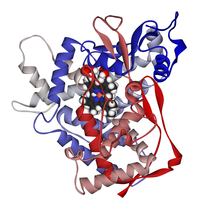
A plant genetic network for preventing dysbiosis in the phyllosphere
Sign Up to like & getrecommendations! Published in 2020 at "Nature"
DOI: 10.1038/s41586-020-2185-0
Abstract: The aboveground parts of terrestrial plants, collectively called the phyllosphere, have a key role in the global balance of atmospheric carbon dioxide and oxygen. The phyllosphere represents one of the most abundant habitats for microbiota… read more here.
Keywords: dysbiosis; plant; genetic network; phyllosphere microbiota ... See more keywords

Allometric relationships between leaf and petiole traits across 31 floating-leaved plants reveal a different adaptation pattern from terrestrial plants
Sign Up to like & getrecommendations! Published in 2023 at "Annals of Botany"
DOI: 10.1093/aob/mcad007
Abstract: Abstract Background and Aims Allometric scaling between stomata and xylem for terrestrial woody plants is a widely observed pattern that may be constrained by water transport. Floating-leaved plants, a particular life form of aquatic plants,… read more here.
Keywords: xylem; leaved plants; area; floating leaved ... See more keywords

The Fat of the Land: Cuticle Formation in Terrestrial Plants
Sign Up to like & getrecommendations! Published in 2020 at "Plant Physiology"
DOI: 10.1104/pp.20.01445
Abstract: In a world surrounded by a vast expanse of gaseous air, water is constantly evaporating from aqueous sources to their surroundings. This is a major problem for microscopic cells containing water essential for life. The… read more here.
Keywords: cuticle formation; water; land cuticle; formation terrestrial ... See more keywords

Marine Bacteroidetes enzymatically digest xylans from terrestrial plants.
Sign Up to like & getrecommendations! Published in 2023 at "Environmental microbiology"
DOI: 10.1111/1462-2920.16390
Abstract: Marine Bacteroidetes that degrade polysaccharides contribute to carbon cycling in the ocean. Organic matter, including glycans from terrestrial plants, might enter the oceans through rivers. Whether marine bacteria degrade structurally related glycans from diverse sources… read more here.
Keywords: marine bacteroidetes; bacteroidetes enzymatically; plants marine; enzymatically digest ... See more keywords

An Overview on Antimicrobial Potential of Edible Terrestrial Plants and Marine Macroalgae Rhodophyta and Chlorophyta Extracts
Sign Up to like & getrecommendations! Published in 2023 at "Marine Drugs"
DOI: 10.3390/md21030163
Abstract: Antibiotics are used to prevent and treat bacterial infections. After a prolonged use of antibiotics, it may happen that bacteria adapt to their presence, developing antibiotic resistance and bringing up health complications. Nowadays, antibiotic resistance… read more here.
Keywords: antimicrobial activity; potential edible; edible terrestrial; antimicrobial potential ... See more keywords

Cyto–Genotoxic Effect Causing Potential of Polystyrene Micro-Plastics in Terrestrial Plants
Sign Up to like & getrecommendations! Published in 2022 at "Nanomaterials"
DOI: 10.3390/nano12122024
Abstract: The polystyrene micro-plastics (Ps-MPs) is one of the leading pollutants found in both aquatic and terrestrial ecosystems. While most of the studies on the morphology and cyto-toxicity of MPs have been based on aquatic organisms,… read more here.
Keywords: micro plastics; effect; micro; polystyrene micro ... See more keywords

Interspecies-Extrapolated Biotic Ligand Model to Predict Arsenate Toxicity to Terrestrial Plants with Consideration of Cell Membrane Surface Electrical Potential
Sign Up to like & getrecommendations! Published in 2022 at "Toxics"
DOI: 10.3390/toxics10020078
Abstract: Arsenic is a metalloid that is highly toxic to living organisms in the environment. In this study, toxicity caused by inorganic arsenate (As(V)) to terrestrial plants, such as barley Hordeum vulgare and wheat Triticum aestivum,… read more here.
Keywords: membrane; biotic ligand; toxicity; terrestrial plants ... See more keywords